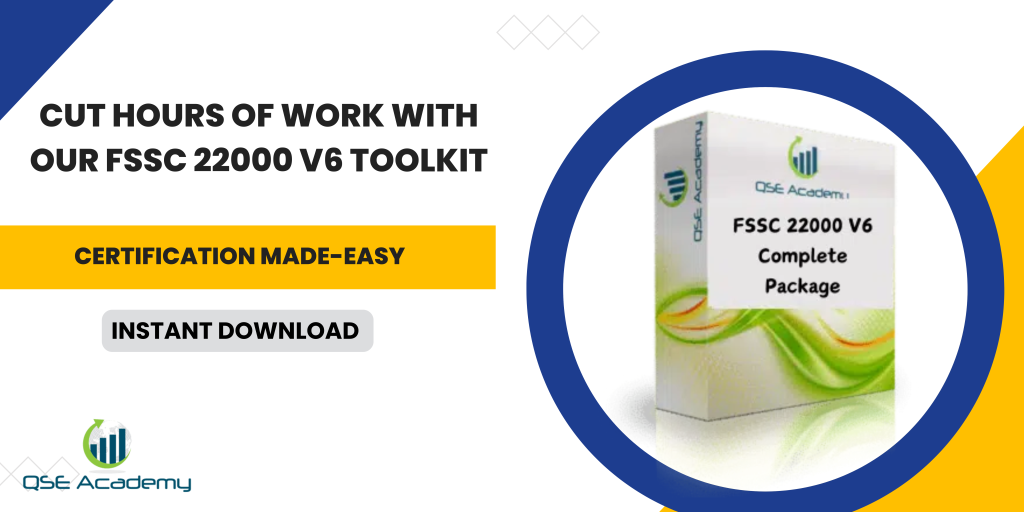FSSC 22000 V6 Glossary: Plain‑English Terms
Why You Need a Plain-English Guide
Let’s be honest — food-safety standards come with a language of their own.
If you’ve ever read an audit report or certification clause and thought, “What does that even mean?”, you’re not alone.
In my years helping manufacturers, packaging producers, and logistics providers implement FSSC 22000, I’ve seen how much time gets wasted trying to decode jargon. Terms like PRPs, OPRPs, and GFSI sound technical, but when you strip them down, they’re practical tools that guide how you run your business safely.
This glossary breaks down the most common FSSC 22000 V6 terms into plain English — so your team can understand them, apply them, and actually use them during audits or daily operations.
Core Concepts Behind FSSC 22000 V6
Before diving into the glossary, here’s the big picture.
FSSC 22000 V6 is built on three layers:
- ISO 22000 — the management-system framework (Plan-Do-Check-Act).
- Prerequisite Programs (PRPs) — hygiene and environmental controls that keep things clean and safe.
- FSSC-specific additions — new GFSI requirements like food defense, food-fraud prevention, culture, and environmental monitoring.
Everything you’ll read below ties back to one of those layers. Once you understand that structure, the terminology starts to make sense.
 Key FSSC 22000 V6 Terms — Explained in Plain English
Key FSSC 22000 V6 Terms — Explained in Plain English
A. Core Framework Terms
Accreditation
This means a certification body (the company that audits you) has been officially approved by a national or international authority. It’s proof they’re competent to issue certificates that count.
Audit
A structured check to see if your system works. Audits can be scheduled (announced) or surprise visits (unannounced). The goal isn’t to find faults — it’s to verify compliance.
Certification Body (CB)
The independent organization that reviews your management system and issues your FSSC 22000 certificate.
Corrective Action
When something goes wrong, corrective action means fixing the root cause, not just patching the symptom.
Example: If temperature logs are missing, the real issue might be lack of staff training — not the missing sheet.
Pro Tip: Keep a simple log showing what went wrong, what you did to fix it, and who verified the correction. Auditors love seeing that traceability.
B. Food-Safety & Risk-Control Terms
CCP (Critical Control Point)
A step where control is essential to prevent or eliminate a food-safety hazard.
Example: Heat treatment during pasteurization — if you miss it, the hazard stays in the product.
HACCP (Hazard Analysis and Critical Control Points)
A systematic approach that identifies hazards, sets control points, and defines monitoring steps. It’s the science behind every food-safety plan.
PRP (Prerequisite Program)
The basic hygiene practices that create a safe environment — cleaning schedules, pest control, staff hygiene, equipment maintenance. Think of them as the foundation of your food-safety house.
OPRP (Operational Prerequisite Program)
These are controls that are important but not critical enough to be CCPs.
Example: Metal detection or packaging seal checks.
Food Fraud
Intentional deception for financial gain — such as mislabeling or adding cheaper ingredients.
Example: Selling sunflower oil as olive oil.
Food Defense
Protecting food from intentional harm, like sabotage or contamination.
Pro Tip: Use simple access controls and visitor sign-ins — they go a long way in protecting your plant.
Food-Safety Culture
The shared mindset across your organization that “food safety is everyone’s job.”
Posting a policy isn’t culture — it’s behavior. When employees speak up about risks, that’s culture.
C. FSSC 22000 V6-Specific Additions
GFSI (Global Food Safety Initiative)
The global network that benchmarks food-safety certification schemes.
If your certification is GFSI-recognized, it’s trusted by retailers worldwide.
FSSC Portal
An online database managed by the Foundation FSSC where certification bodies upload audit data. It keeps everything transparent and verifiable.
Scope Categories
Defined groups that describe what kind of operation you run — manufacturing, catering, packaging, storage, or feed.
Example: Category C for food processing, Category I for packaging materials.
Environmental Monitoring
Regular testing of surfaces, air, and water to make sure the production area stays clean.
Example: Swabbing conveyor belts for listeria or yeast.
Management of Services
Controlling outsourced work that affects food safety — like pest control, cleaning, or transport. You must ensure suppliers meet your standards too.
Unannounced Audit
A surprise audit that tests if your system works day-to-day.
Pro Tip: If you maintain records daily and keep your team trained, an unannounced audit won’t feel stressful — it’ll feel normal.
D. Documentation & System Terms
Documented Information
All your managed data — policies, records, checklists, and digital forms. It shows proof that your system runs as designed.
Traceability
The ability to follow a product’s journey from supplier to final customer.
Example: If there’s a recall, you can trace which batch used which ingredients.
Non-Conformity (NC)
Any deviation from your planned process or a clause requirement. Minor NCs are small issues; major NCs affect food safety directly.
Verification
Confirming that a control works as intended.
Example: Checking that your thermometer reads accurately before use.
Validation
Proving that a control will work before you rely on it.
Example: Testing your pasteurization parameters in the lab before production.
Pro Tip: Validation = proving it works in theory. Verification = proving it works in practice. Auditors often check both.
Real-World Application — Turning Definitions Into Action
Knowing the words is one thing; applying them makes the real difference.
Use this glossary to:
- Train new employees on key FSSC concepts.
- Prepare for audits with clear definitions everyone understands.
- Align departments — production, quality, and logistics — on a shared vocabulary.
Example: During one client’s pre-audit, a forklift operator confidently explained “traceability” in his own words. The auditor noted it as evidence of strong food-safety culture. That’s what understanding does — it empowers everyone.
Pro Tip: Add these definitions to your internal manual or display them on your training boards. It shows commitment to education and clarity.
FAQs — Clearing Up Common Confusion
Q1: What’s the difference between PRP and OPRP?
PRPs prevent general contamination (like cleaning and hygiene).
OPRPs prevent specific hazards (like metal detection or sieving) that aren’t quite CCPs.
Q2: Is FSSC 22000 the same as GFSI?
No. GFSI is the global benchmarking body; FSSC 22000 is one of the certification schemes recognized by GFSI.
Q3: Do I need to memorize every definition?
Not at all. Focus on understanding what each term means for your operation — auditors care more about practical application than textbook recall.
Conclusion — Making FSSC 22000 V6 Easy to Understand
Food-safety systems don’t need to sound intimidating. Once your team understands the language, implementation becomes easier, audits go smoother, and confidence grows across every department.
When everyone speaks the same food-safety language, compliance stops being a checklist — it becomes a shared responsibility.
Next step:
Download QSE Academy’s “FSSC 22000 V6 Glossary in Plain English” or book a quick consultation to train your staff using simplified, real-world explanations of every key term.
Melissa Lavaro is a seasoned ISO consultant and an enthusiastic advocate for quality management standards. With a rich experience in conducting audits and providing consultancy services, Melissa specializes in helping organizations implement and adapt to ISO standards. Her passion for quality management is evident in her hands-on approach and deep understanding of the regulatory frameworks. Melissa’s expertise and energetic commitment make her a sought-after consultant, dedicated to elevating organizational compliance and performance through practical, insightful guidance.








